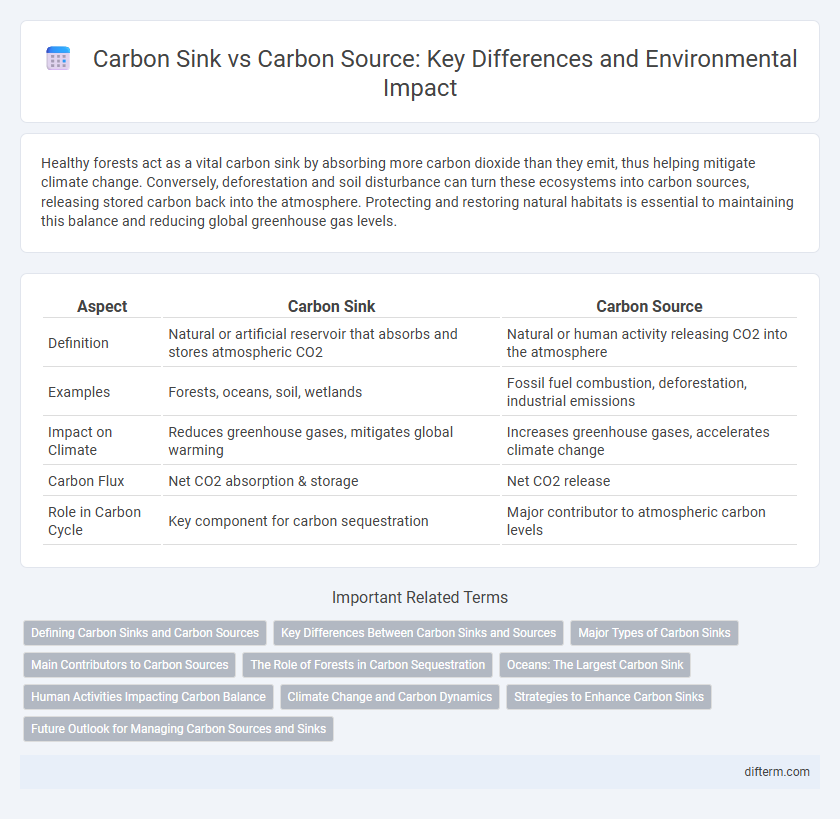Healthy forests act as a vital carbon sink by absorbing more carbon dioxide than they emit, thus helping mitigate climate change. Conversely, deforestation and soil disturbance can turn these ecosystems into carbon sources, releasing stored carbon back into the atmosphere. Protecting and restoring natural habitats is essential to maintaining this balance and reducing global greenhouse gas levels.
Table of Comparison
| Aspect | Carbon Sink | Carbon Source |
|---|---|---|
| Definition | Natural or artificial reservoir that absorbs and stores atmospheric CO2 | Natural or human activity releasing CO2 into the atmosphere |
| Examples | Forests, oceans, soil, wetlands | Fossil fuel combustion, deforestation, industrial emissions |
| Impact on Climate | Reduces greenhouse gases, mitigates global warming | Increases greenhouse gases, accelerates climate change |
| Carbon Flux | Net CO2 absorption & storage | Net CO2 release |
| Role in Carbon Cycle | Key component for carbon sequestration | Major contributor to atmospheric carbon levels |
Defining Carbon Sinks and Carbon Sources
Carbon sinks are natural or artificial reservoirs that absorb and store more carbon dioxide from the atmosphere than they release, such as forests, oceans, and soil. Carbon sources, in contrast, emit more carbon dioxide than they absorb, including activities like fossil fuel combustion, deforestation, and certain agricultural practices. Understanding the balance between carbon sinks and sources is crucial for addressing climate change and managing global carbon cycles effectively.
Key Differences Between Carbon Sinks and Sources
Carbon sinks absorb and store more carbon dioxide than they release, significantly reducing greenhouse gases and mitigating climate change, with forests, oceans, and soil being primary examples. In contrast, carbon sources emit more carbon dioxide into the atmosphere than they capture, often due to human activities like fossil fuel combustion and deforestation. Understanding the balance between carbon sinks and sources is crucial for developing effective strategies to manage global carbon cycles and achieve net-zero emissions.
Major Types of Carbon Sinks
Major types of carbon sinks include forests, oceans, and soil, each playing a crucial role in absorbing and storing atmospheric carbon dioxide. Forests capture carbon through photosynthesis, storing it in biomass and soil, while oceans absorb nearly a quarter of global CO2 emissions through physical and biological processes. Soils act as significant carbon reservoirs by sequestering organic carbon from plant and microbial activity, helping to mitigate climate change by balancing carbon source emissions.
Main Contributors to Carbon Sources
Deforestation and fossil fuel combustion are the primary contributors to carbon sources, releasing vast amounts of CO2 into the atmosphere. Industrial processes and agricultural activities also emit significant greenhouse gases, intensifying climate change. These human-driven sources outweigh natural carbon sinks like forests and oceans, disrupting the global carbon balance.
The Role of Forests in Carbon Sequestration
Forests act as vital carbon sinks by absorbing approximately 2.6 billion tons of CO2 annually, significantly mitigating atmospheric carbon dioxide levels. They store carbon in biomass and soil, offsetting emissions from carbon sources like fossil fuel combustion. Maintaining forest health and preventing deforestation are crucial strategies to enhance carbon sequestration and combat climate change.
Oceans: The Largest Carbon Sink
Oceans act as the largest natural carbon sink, absorbing approximately 25-30% of global CO2 emissions annually through physical and biological processes. Marine phytoplankton convert dissolved CO2 into organic matter via photosynthesis, sequestering carbon in deep ocean waters and sediments. However, increasing ocean temperatures and acidification threaten the oceans' capacity to store carbon, potentially altering the balance between carbon sinks and sources.
Human Activities Impacting Carbon Balance
Human activities such as deforestation, fossil fuel combustion, and industrial processes significantly increase carbon emissions, transforming natural carbon sinks like forests and oceans into carbon sources. Agricultural practices and urbanization alter soil carbon storage, reducing the earth's capacity to absorb CO2. The imbalance between emitted and absorbed carbon intensifies atmospheric greenhouse gas concentrations, driving climate change and ecosystem disruption.
Climate Change and Carbon Dynamics
Carbon sinks absorb more carbon dioxide than they release, playing a crucial role in mitigating climate change by reducing atmospheric CO2 levels. Conversely, carbon sources, such as deforestation and fossil fuel combustion, emit more carbon dioxide than they sequester, intensifying global warming and disrupting carbon dynamics. Understanding the balance between carbon sinks and sources is essential for developing effective climate policies and achieving carbon neutrality goals.
Strategies to Enhance Carbon Sinks
Enhancing carbon sinks involves expanding forested areas, restoring wetlands, and adopting sustainable agricultural practices that increase soil carbon sequestration. Techniques such as afforestation, reforestation, and biochar application significantly boost the capacity of natural ecosystems to absorb atmospheric CO2. Protecting existing carbon-rich habitats and improving land management are critical strategies to mitigate climate change by maximizing carbon storage.
Future Outlook for Managing Carbon Sources and Sinks
Effective management of carbon sources and sinks is critical for mitigating climate change impacts and achieving net-zero emissions targets by 2050. Innovations in carbon capture technology, reforestation efforts, and soil carbon sequestration are projected to enhance natural and artificial carbon sinks, while reducing fossil fuel dependency is essential to minimize carbon sources. Policy frameworks promoting sustainable land use, renewable energy adoption, and carbon pricing mechanisms will play a pivotal role in balancing carbon fluxes and stabilizing global atmospheric CO2 levels.
carbon sink vs carbon source Infographic

 difterm.com
difterm.com